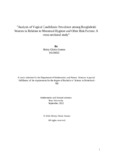| dc.contributor.advisor | Islam, Mohammad Rafiqul | |
| dc.contributor.author | Gomes, Bristy Gloria | |
| dc.date.accessioned | 2023-04-11T04:17:18Z | |
| dc.date.available | 2023-04-11T04:17:18Z | |
| dc.date.copyright | 2022 | |
| dc.date.issued | 2022-09 | |
| dc.identifier.other | ID: 16136032 | |
| dc.identifier.uri | http://hdl.handle.net/10361/18136 | |
| dc.description | This thesis is submitted in partial fulfillment of the requirements for the degree of Bachelor of Science in Biotechnology 2022. | en_US |
| dc.description | Catalogued from PDF version of thesis. | |
| dc.description | Includes bibliographical references (pages 122-133). | |
| dc.description.abstract | Vaginal candidiasis, which is an infection of the female reproductive system, continues to be a
leading risk factor of morbidity, which negatively impact the physical and mental health of
women worldwide. As the second most common kind of vaginal infection, this illness affects
many women. Candida albicans, the fungus that causes vaginal candidiasis (VC), continues to
be a major health issue for reproductive-age women. Despite widespread awareness, vaginal
candidiasis is still seen as a minor health issue in many impoverished nations like Bangladesh.
This study aimed to examine and evaluate the prevalence of vaginal candidiasis and its associa tion with menstrual hygiene and other risk factors among reproductive-aged women. This
cross-sectional study was carried out at AK memorial hospital, Maona, Gazipur and Lubana
General Hospital & Uttara Cardiac Center. The total number of participants were 244, among
them 91 tested positive for Vaginal Candidiasis. Among the participants, prevalence of Vaginal
Candidiasis was mostly seen on women aged between 15 to 34 (66%) and also in 70.3% pa tients who are married. According to the educational background and social status, prevalence
of this disease is mostly seen on women of lower middle class and with higher secondary edu cation. Another major part of the study is to know about the relation between menstrual hy giene and vaginal candidiasis. About 33% of the women use cloth and another 33% use both
sanitary napkin and cloth as an absorbent. 68% women change the absorbent only about 1-2
times per day. Because of these practices poor menstrual hygiene is detected as the most
causative factor of Vaginal Candidiasis among these women from this study (about 35%). This
study also investigates the various symptoms and problems experienced by people with vaginal
candidiasis. In developing country like ours, in most of cases this disease is treated after only
doing pelvic examination. Though, Vaginal Candidiasis is a type of mild infection for most the
cases still it needs to be given importance as it can cause troublesome and serious complica tions such as recurrent infection, candidemia etc. | en_US |
| dc.description.statementofresponsibility | Bristy Gloria Gomes | |
| dc.format.extent | 133 pages | |
| dc.language.iso | en | en_US |
| dc.publisher | Brac University | en_US |
| dc.rights | Brac University theses are protected by copyright. They may be viewed from this source for any purpose, but reproduction or distribution in any format is prohibited without written permission. | |
| dc.subject | Vaginal Candidiasis | en_US |
| dc.subject | Menstrual hygiene | en_US |
| dc.subject | Menstrual absorbent | en_US |
| dc.subject | Absorbent change rate | en_US |
| dc.subject | Pelvic examination | en_US |
| dc.subject | Recurrent infection | en_US |
| dc.subject.lcsh | Candidiasis--Treatment. | |
| dc.title | Analysis of Vaginal Candidiasis Prevalence among Bangladeshi women in relation to menstrual hygiene and other risk factors: A cross-sectional study | en_US |
| dc.type | Thesis | en_US |
| dc.contributor.department | Department of Mathematics and Natural Sciences, Brac University | |
| dc.description.degree | B. Biotechnology | |

